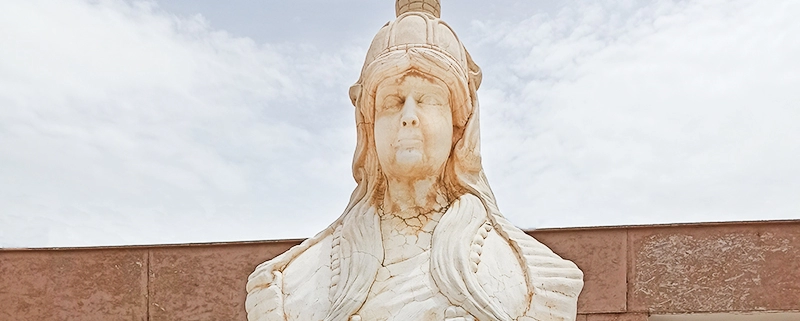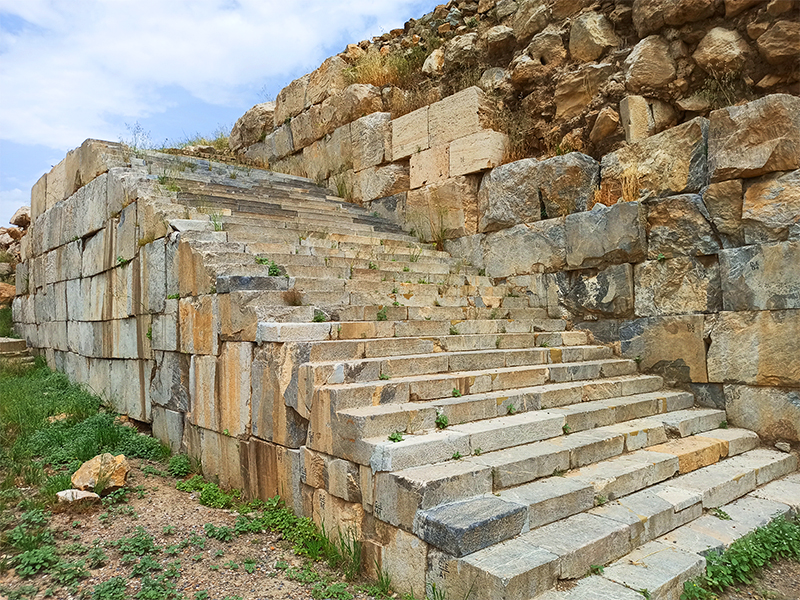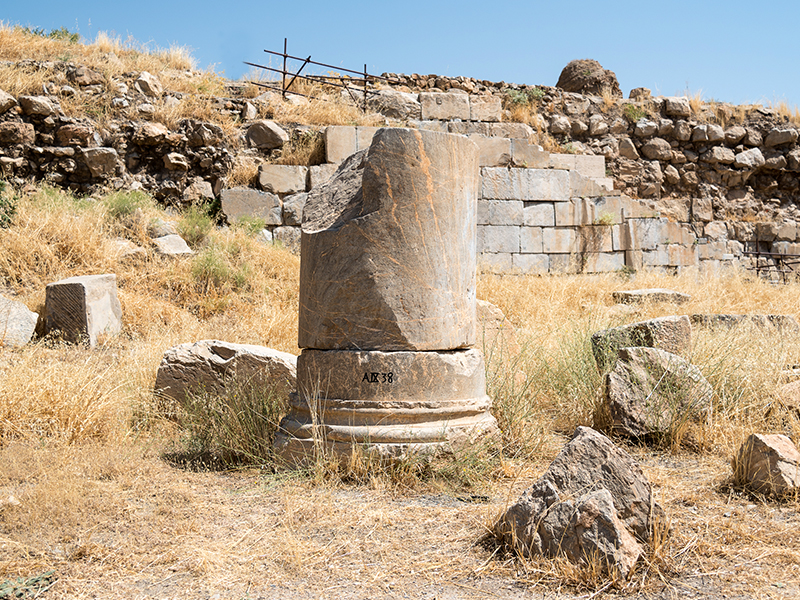Anahita Temple, Kangavar (History, Architecture, Location)
The Anahita Temple is one of the amazing sites in Kangavar, which is known as the second stone monument of Iran after Persepolis. Its historical importance is in the three periods of the Achaemenids, Arsacids, and Sassanians. While some believe the temple was built to worship the goddess of water, others consider it a half-completed palace attributed to Khosrow Parviz. This outstanding building was registered as one of the first national treasures of Iran in 1931.
Today, we start a journey to discover the mysterious Anahita Temple and explore its history and architecture. Although much of its structure has faded, this temple holds many stories and secrets within its walls. Join us as we delve into the mysterious depths of ancient Iranian history and find out more about the magnificent Anahita Temple in Kangavar.
Anahita Temple Kangavar History
The history of Anahita Temple, which is dedicated to the worship and respect of the goddess of water in ancient Iran, goes back to the era before the common era, which is recorded in historical documents. The initial construction of this temple was done during the Achaemenid period, and its construction continued in the following periods and ended in the Sasanian period. After the rise of Islam in Iran, significant changes were made to the structure, such that the northwest side was changed to accommodate Imamzadeh Ibrahim, the mosque, and the bazaar.
Considering the passage of several centuries since the construction of the temple, along with natural disasters and accidental or intentional human interventions, it is challenging to determine the exact date of construction, architectural use, and spatial characteristics. However, some researchers, relying on the writings of Iranian and Arab historians from the third century Hijri onwards, consider this building to be the unfinished palace of Khosrow Parviz. Others attribute its construction to the late 3rd or early 2nd century BC, while others date it to the 1st century BC.
Anahita Temple of Mystery
There are many stories and traditions about the Anahita temple treasure. Undoubtedly, such a valuable work contains historical treasures of different periods. However, the mystery of Anahita Temple lies in its historical significance:
- The northern facade of the temple remains unexplored. Perhaps due to its subsidiary role, this side lacks any columns and features distinct architecture from the other sides.
- In the eastern facade of the temple, during archaeological excavations in the 1940s, a barrel-shaped coffin and a rock-cut burial site from the Parthian era were discovered.
- The famous French archaeologist Girshman compares the temple to the Khurha and Laodicea temples in Nahavand, attributing its construction to around 200 BCE.
- Artifacts from all historical periods after the Parthians, including Sassanid, Seljuk, and Safavid, have been found in the temple.
- Hertzfeld, an archaeologist of the Pahlavi era in Iran, considers the Anahita Temple in Kangavar to be one of the largest ancient temples in the world.
Anahita Fire Temple Architecture
Anahita Temple, located on a rocky platform, is 220 meters long and 210 meters wide, surrounded by a massive wall more than 5 meters thick. The entrance of the structure has two-way stairs on the south side and one-way stairs on the north side, which completes the temple building.
Stone channels intricately direct the river water to the magnificent central pool of Anahita Temple. The engineering marvel of water division and flow in the temple in ancient times was aimed at presenting this sacred element in the most beautiful form.
On the four sides of the temple, there are channels with running water that direct the water back and forth towards the center of the temple. On both sides of the top of the Anahita temple, four cow heads are placed facing each other, which creates a reflection of their heads on the water during the water collection ceremony of the temple. At the center of the temple, a space collects the water from these channels in a small tank measuring approximately 10 x 10 meters and 20 cm deep. The Anahita Temple in Kangavar is the most renowned temple dedicated to Anahita in Iran.
Anahita, Goddess of Water
Anahita is not merely the name of a goddess in ancient Iran; it is a symbol of a cultural era characterized by the worship and respect for water. Water had a special place in Mithraic rites, where it symbolized Anahita. As the divine guardian of water, Anahita is portrayed as the embodiment of purity, overseeing rain and springs.
Some consider Anahita to be the most beloved deity among the Aryans. As the goddess of love and friendship, she is also a symbol of fertility and childbirth. Anahita’s presence becomes clearly evident from the Achaemenid era, and historical artifacts, such as the Kangavar Temple, continue to reflect the importance of the water goddess for the Iranians through the Sassanian period.
Anahita’s name has always stood alongside Ahura Mazda, enduring in the inscriptions of the Taq-e Bostan in Kermanshah. From the Achaemenid era to the Sassanian period, Anahita remains an integral part of Iranian culture, showing the significance of water worship and the enduring values associated with this revered goddess.
Anahita Temple Usage
According to existing writings and discoveries made on the Anahita Temple, it is said to have served as a fire temple for the reverence and worship of the water goddess. However, after the advent of Islam in Iran, the temple underwent changes, leading to numerous speculations and hypotheses regarding its usage. The transformations that occurred in the Islamic period have created many ambiguities and guesses about the main purpose and function of this temple.
Discovered Objects
One of the most important discoveries of the temple includes coffins and their contents, which were obtained from Parthian tombs. Among the items obtained from these graves are daggers, bronze vessels, bracelets, earrings with winged motifs, clay vessels, etc. Some of these works were previously exhibited in the Kangavar City Museum, and unfortunately, some others were victims of theft from this museum.
Other historical objects found in Anahita Temple include coins and ceramics from the Islamic era and the rule of the Islamic caliphs. Among the various glazed ceramics of the Seljuk period, carved and engraved ceramics from the Seljuk and green and yellow colored ceramics known as Nishapur pottery (from the beginning of the 5th century Hijri to the beginning of the Islamic period) are noteworthy.
Time to Visit Anahita Kangavar Temple
The best time to visit the Anahita Kangavar Temple is during the spring and autumn seasons. Anahita Temple is open to the public all year round except for important religious occasions. The visiting hours for the Anahita Temple are from 8 am to 7 pm. This allows ample time for visitors to explore and appreciate the historical and architectural wonders of the temple during daylight hours.
Anahita Temple Reviews
The Temple of Anahita in Kangavar is widely praised as one of Iran’s most impressive and enigmatic archaeological treasures. Reviewers on Wanderlog highlight its vast stone platform—second only to Persepolis—covering over six acres with massive columns and defensive walls that evoke Achaemenid grandeur.
Visitors appreciate the blend of Achaemenid, Parthian, and Sassanian architectural styles and enjoy wandering its terraces and staircases, though many note that preservation issues mean it’s “almost completely ruined” and would be more engaging with a guide.
Most travelers find it to be a must-see site in Kangavar—a “hidden gem” offering poignant glimpses into Persia’s water-centric spirituality and grandeur, even in its ruined state.
Anahita Temple Location
The Anahita Temple is located in the city of Kangavar, on Enghelab Boulevard and Shahid Street, in the Kermanshah Province. To visit this temple, you have to travel to the Kermanshah Province, with Kangavar situated 94 kilometers away from the city of Kermanshah. The temple is located in Kangavar, along the Hamedan-Kermanshah road, and reaching it requires heading towards the center of Kangavar and Shahid Street (Location on map)
Final Word
In short, Anahita Temple in Kangavar is a special place in ancient Iran where the people honored the water goddess Anahita. This temple has a fascinating history and unique features that make it an attractive destination. You can visit it in spring or autumn; it’s open for exploration all year round. Anahita Temple gives us a glimpse of the ancient traditions of Iran and the importance given to water worship, so don’t miss the opportunity to visit it.
Are you planning to travel to Iran and looking for an Iran travel agency? Check out our Iran tours. Find more interesting Things to Do in Kermanshah.








Hey, I am working for a small documentary Film production company from Germany. Currently working on a Film about the history of Iran. I am researching photos of the Anahita Temple and luckily came across your blog entry. I am specifically interested in the very first Picture depicting the staue of Anahita. Is it perhaps possible to use this Photo of yours? Its very hard to find good Photos of it. Any Help is appreciated.
Sincerely, Sonja
Thank you for reaching out and for your interest in our blog! We’re glad you found the photo helpful. Just to clarify, the statue of Anahita depicted in the first picture is not an ancient monument. it was recently created as a modern representation to bring the goddess to life visually. Considering this, you are welcome to use the photo for your documentary. We’d be happy to support your project on the history of Iran.
Please don’t hesitate to reach out if you need anything else!